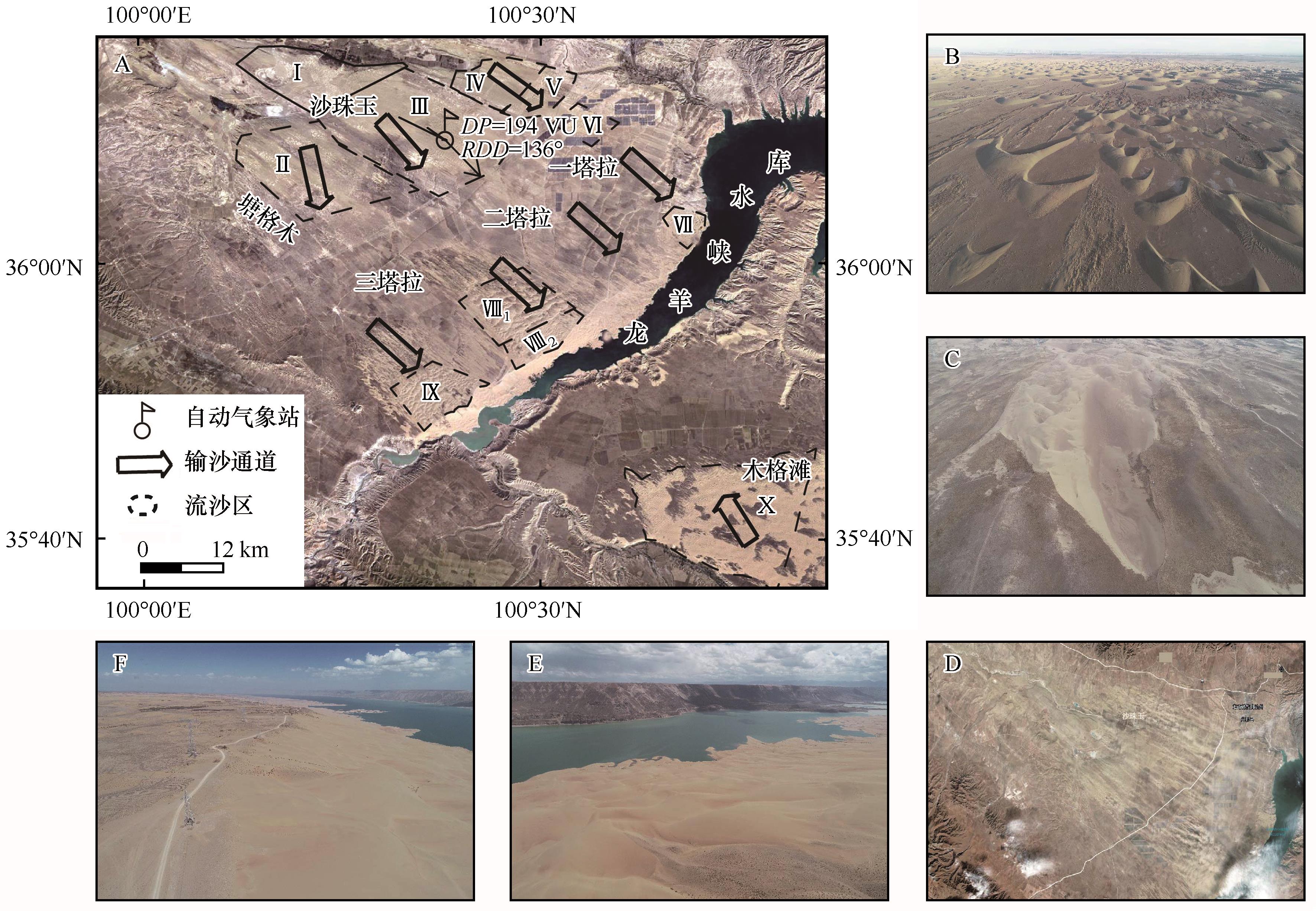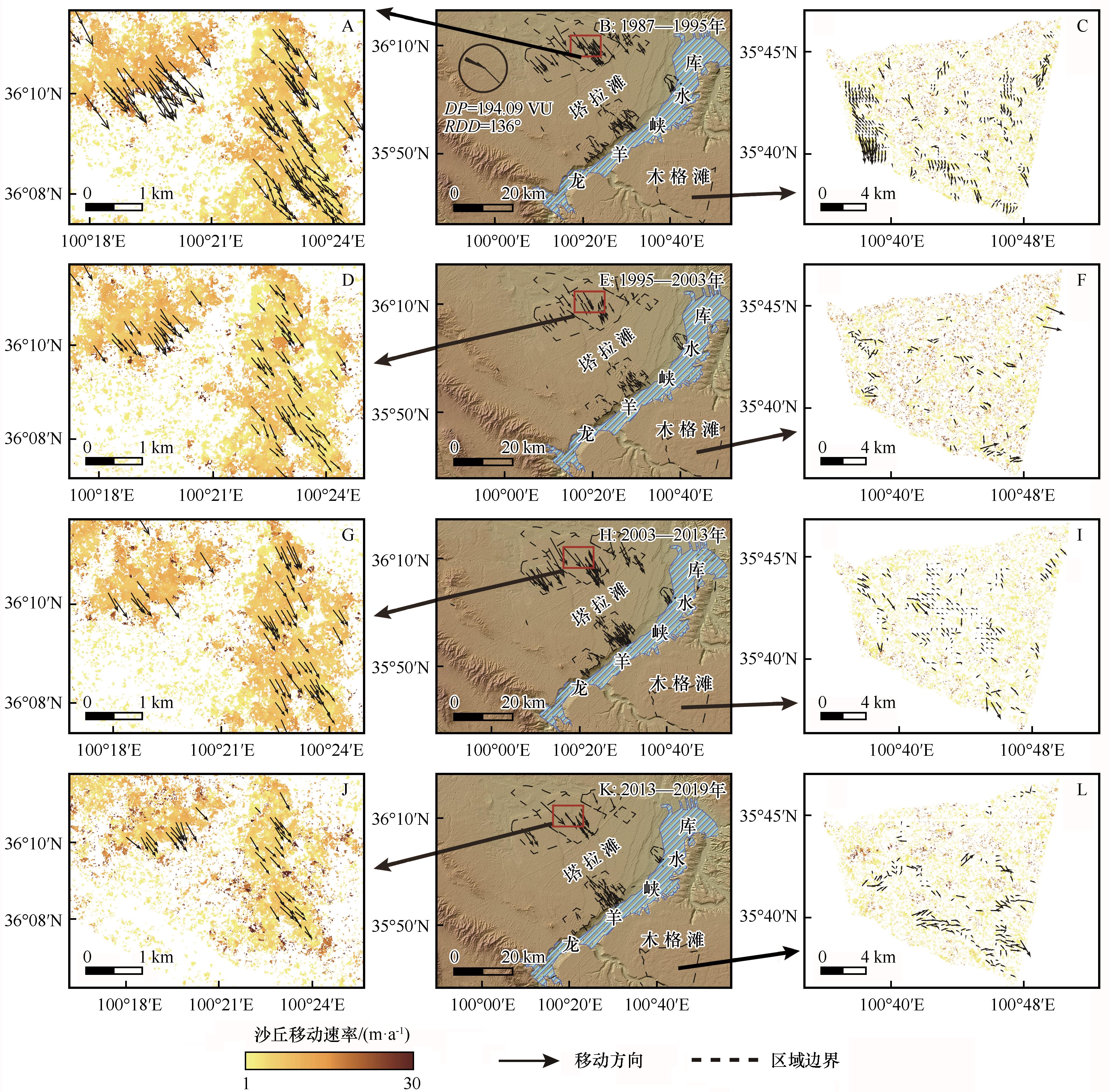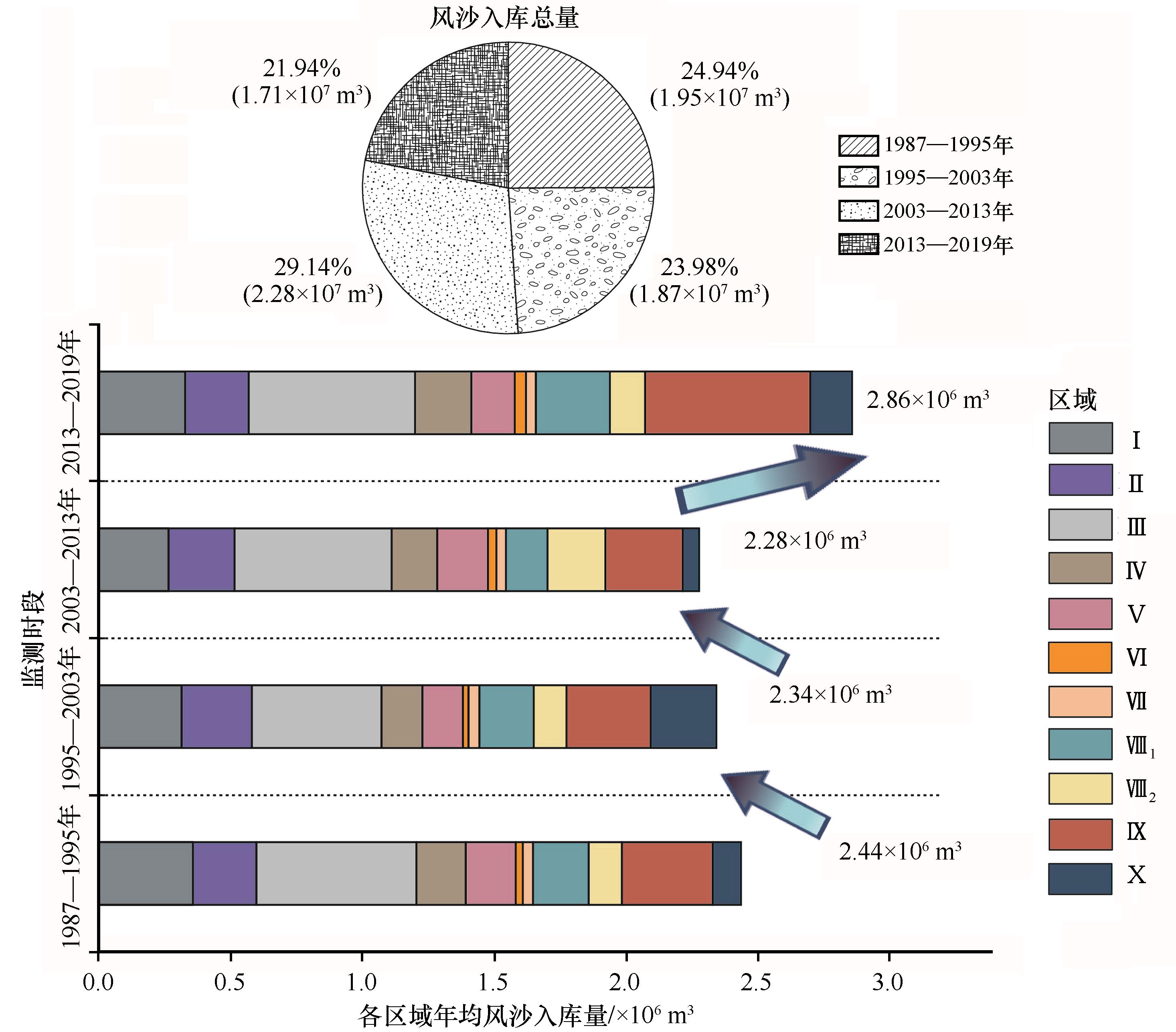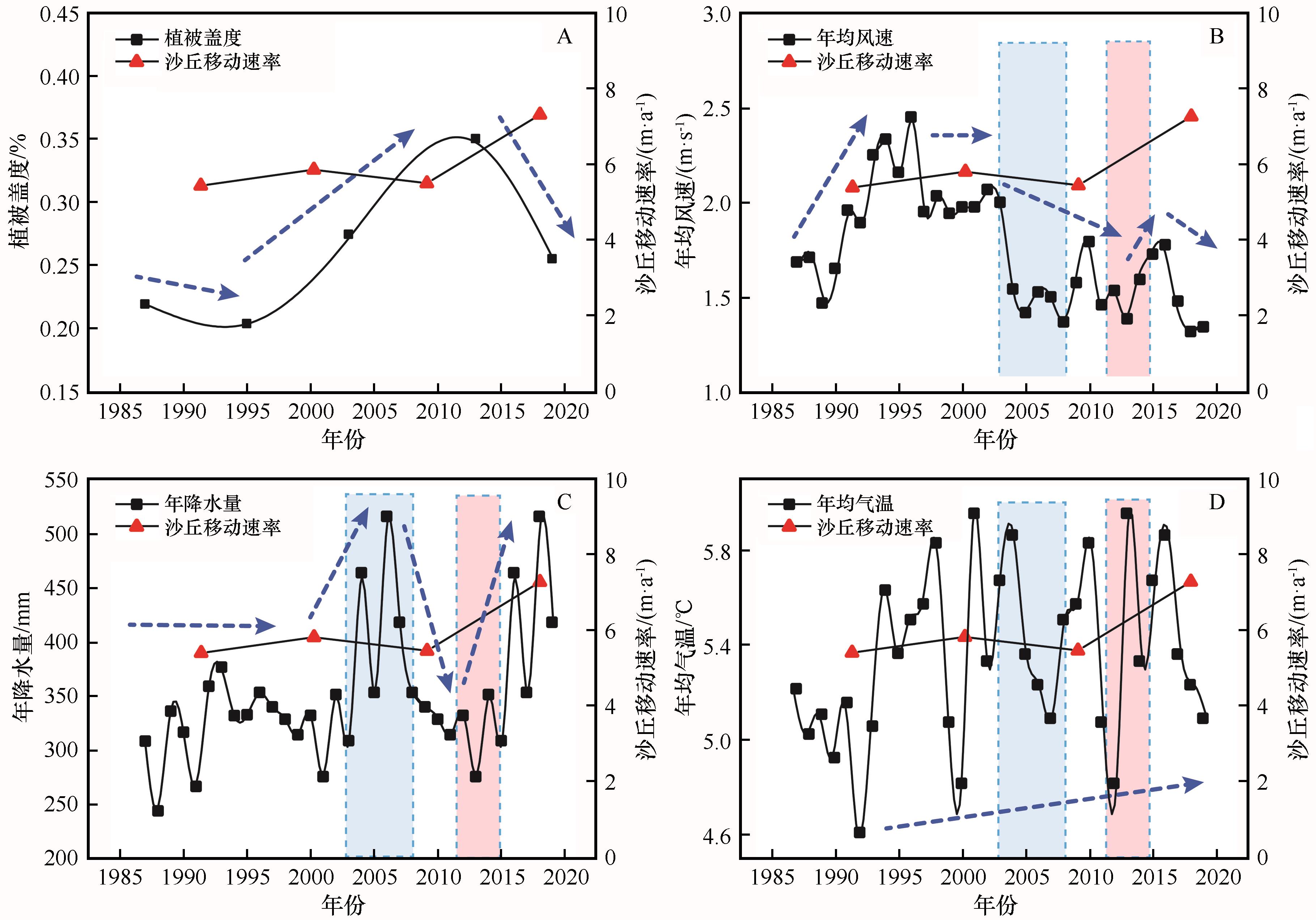
- CN 62-1070/P
- ISSN 1000-694X
- Bimonthly 1981

Journal of Desert Research ›› 2021, Vol. 41 ›› Issue (6): 249-261.DOI: 10.7522/j.issn.1000-694X.2021.00154
Previous Articles Next Articles
Mei Shao1,2( ), Wanyin Luo1(
), Wanyin Luo1( ), Xuehua Che1,2, Fang Wang1, Junfeng Lu1, Songbing Zou3
), Xuehua Che1,2, Fang Wang1, Junfeng Lu1, Songbing Zou3
Received:2021-10-09
Revised:2021-11-04
Online:2021-11-20
Published:2021-12-17
Contact:
Wanyin Luo
CLC Number:
Mei Shao, Wanyin Luo, Xuehua Che, Fang Wang, Junfeng Lu, Songbing Zou. Aeolian sand transport and its potential amount into Longyangxia Reservoir in 1987-2019 based on COSI-Corr[J]. Journal of Desert Research, 2021, 41(6): 249-261.
Add to citation manager EndNote|Ris|BibTeX
URL: http://www.desert.ac.cn/EN/10.7522/j.issn.1000-694X.2021.00154

Fig.1 Landscape and sand transport corridors around Longyangxia Reservoir (A: The sand transport corridors of major sand areas, and Ⅰ—Ⅹ represent the different sandy land areas. Figure B and C represent the sand source in different area, figure B shows the dune in ErTala, figure C represents the mega-blowout in SanTala; Figure D represents the sand storm monitored by satellite; Figure E and F are the current situation of sand transported into the reservoir. In the southeast side of the reservoir area (Mugetan sandy-land), continuous dunes are distributed, which are more mature, while in the northwest side of the reservoir area (Talatan sandy-land), dunes are scattered, lightly developed and with low dune height)
| 卫星影像名称 | 时间 | 波段 | 分辨率/m | 太阳高度角/(°) | 太阳方位角/(°) | 云量/% |
|---|---|---|---|---|---|---|
| LT51330351987227BJC00 | 1987-08-15 | 4 | 30 | 55.09 | 120.72 | 4 |
| LT51330351995217CLT00 | 1995-08-05 | 4 | 30 | 52.55 | 110.59 | 7 |
| LT51330352003255BJC00 | 2003-09-12 | 4 | 30 | 50.46 | 137.21 | 13 |
| LC81330352013106LGN01 | 2013-04-16 | 4 | 30 | 58.32 | 139.17 | 0.19 |
| LC08_L1TP_133035_20190722_20190801_01_T1 | 2019-07-22 | 4 | 30 | 64.81 | 122.50 | 18.42 |
Table 1 The parameters of metadata used for COSI-Corr calculating around Longyangxia Reservoir
| 卫星影像名称 | 时间 | 波段 | 分辨率/m | 太阳高度角/(°) | 太阳方位角/(°) | 云量/% |
|---|---|---|---|---|---|---|
| LT51330351987227BJC00 | 1987-08-15 | 4 | 30 | 55.09 | 120.72 | 4 |
| LT51330351995217CLT00 | 1995-08-05 | 4 | 30 | 52.55 | 110.59 | 7 |
| LT51330352003255BJC00 | 2003-09-12 | 4 | 30 | 50.46 | 137.21 | 13 |
| LC81330352013106LGN01 | 2013-04-16 | 4 | 30 | 58.32 | 139.17 | 0.19 |
| LC08_L1TP_133035_20190722_20190801_01_T1 | 2019-07-22 | 4 | 30 | 64.81 | 122.50 | 18.42 |

Fig.5 Spatial and temporal distribution characteristics of dune movement around Longyangxia Reservoir from 1987 to 2019 using COSI-Corr (A, D, G and J are the vector diagrams of the moving rate and direction of dunes in the local area of upwind; B, E, H and K are the vector diagrams of the dune movement of the study area in1987-1995, 1995-2003, 2003-2013 and 2013-2019; C, F, I and L are the vector diagrams of the migration rate and direction of dunes in the local area of downwind)
| 区域 | Ⅰ | Ⅱ | Ⅲ | Ⅳ | Ⅴ | Ⅵ | Ⅶ | Ⅷ1 | Ⅷ2 | Ⅸ | Ⅹ |
|---|---|---|---|---|---|---|---|---|---|---|---|
| Lk/m | 12 309 | 13 325 | 13 965 | 7 318 | 8 413 | 4 232 | 3 845 | 9 624 | 9 649 | 7 729 | 18 664 |
| ak 1987—1995 | 0.77 | 0.83 | 0.80 | 0.80 | 0.84 | 0.74 | 0.99 | 0.86 | 0.91 | 0.90 | 0.08 |
| ak 1995—2003 | 0.70 | 0.75 | 0.73 | 0.75 | 0.72 | 0.61 | 0.94 | 0.77 | 0.87 | 0.80 | 0.11 |
| ak 2003—2013 | 0.61 | 0.73 | 0.74 | 0.64 | 0.78 | 0.70 | 0.94 | 0.87 | 0.91 | 0.92 | 0.07 |
| ak 2013—2019 | 0.61 | 0.65 | 0.69 | 0.73 | 0.69 | 0.53 | 0.66 | 0.83 | 0.79 | 0.52 | 0.09 |
| bk | 0.46 | 0.41 | 0.54 | 0.31 | 0.35 | 0.18 | 0.17 | 0.3 | 0.3 | 1 | 1 |
Table 2 The parameters in the calculation of potential amount of sand transported into the Longyangxia Reservoir
| 区域 | Ⅰ | Ⅱ | Ⅲ | Ⅳ | Ⅴ | Ⅵ | Ⅶ | Ⅷ1 | Ⅷ2 | Ⅸ | Ⅹ |
|---|---|---|---|---|---|---|---|---|---|---|---|
| Lk/m | 12 309 | 13 325 | 13 965 | 7 318 | 8 413 | 4 232 | 3 845 | 9 624 | 9 649 | 7 729 | 18 664 |
| ak 1987—1995 | 0.77 | 0.83 | 0.80 | 0.80 | 0.84 | 0.74 | 0.99 | 0.86 | 0.91 | 0.90 | 0.08 |
| ak 1995—2003 | 0.70 | 0.75 | 0.73 | 0.75 | 0.72 | 0.61 | 0.94 | 0.77 | 0.87 | 0.80 | 0.11 |
| ak 2003—2013 | 0.61 | 0.73 | 0.74 | 0.64 | 0.78 | 0.70 | 0.94 | 0.87 | 0.91 | 0.92 | 0.07 |
| ak 2013—2019 | 0.61 | 0.65 | 0.69 | 0.73 | 0.69 | 0.53 | 0.66 | 0.83 | 0.79 | 0.52 | 0.09 |
| bk | 0.46 | 0.41 | 0.54 | 0.31 | 0.35 | 0.18 | 0.17 | 0.3 | 0.3 | 1 | 1 |

Fig.7 The spatial and temporal characteristics of potential amount of sand transported into the reservoir (The pie chart showed the total potential amount of sand transported into the reservoir in each period; the histogram showed the annual potential amount of sand transported into the reservoir)

Fig.8 Factors influencing sand transportation (A: The trend change of vegetation cover and dune migration rate; B: The trend change of annual wind speed and dune migration rate; C: The trend change of annual precipitation and dune migration rate; D: The trend change of annual temperature and dune migration rate. The blue dotted arrow represents the change trend of each factor)
| 1 | 徐勇,王传胜.黄河流域生态保护和高质量发展:框架、路径与对策[J].中国科学院院刊,2020,35(7):875-883. |
| 2 | 马柱国,符淙斌,周天军,等.黄河流域气候与水文变化的现状及思考[J].中国科学院院刊,2020,35(1):52-60. |
| 3 | 郑子彦,吕美霞,马柱国.黄河源区气候水文和植被覆盖变化及面临问题的对策建议[J].中国科学院院刊,2020,35(1):61-72. |
| 4 | Bullard J E,Livingstone I.Interactions between aeolian and fluvial systems in dryland environments[J].Area,2002,34(1):8-16. |
| 5 | 宋阳,严平,杜建会,等.巴图湾水库风沙入库量的估算[J].干旱区资源与环境,2008,22(5):68-73. |
| 6 | Belnap J,Munson S M,Field J P.Aeolian and fluvial processes in dryland regions:the need for integrated studies[J].Ecohydrology,2011,4(5):615-622. |
| 7 | Moustafa W M,Hussien R A,Nassar N.Evaluation of potential hazards associated with qattara depression as a national hydropower project in Egypt[J].Arab Journal of Nuclear Sciences and Applications,2018,51(2):58-67. |
| 8 | 段庆光,石蒙沂,王斌,等.龙羊峡库区风沙现状及其对库区的影响[J].干旱区研究,1990,8:22-29. |
| 9 | 姚檀栋,朱立平.青藏高原环境变化对全球变化的响应及其适应对策[J].地球科学进展,2006,21(5):459-464. |
| 10 | 杨根生,刘阳宜,史培军.黄河沿岸风成沙入黄沙量估算[J].科学通报,1988,13:1017-1021. |
| 11 | 方学敏.黄河干流宁蒙河段风沙入黄量计算[J].人民黄河,1993,4:1-4. |
| 12 | 高宏智,邹桂香.龙羊峡水库周围风沙流观测、计算及对库区的影响[J].干旱区资源与环境,1989,3(1):59-69. |
| 13 | 杨东亮,王雪芹,胡永锋,等.风沙流输沙通量垂向分布研究:以塔克拉玛干沙漠南缘流沙地表风沙流观测为例[J].中国沙漠,2012,32(3):631-639. |
| 14 | 韩致文,缑倩倩,杜鹤强,等.新月形沙丘表面100 cm高度内风沙流输沙量垂直分布函数分段拟合[J].地理科学,2012,32(7):892-897. |
| 15 | 毛东雷,蔡富艳,雷加强,等.新疆策勒河下游塔克拉玛干沙漠南缘风沙活动特征[J].干旱区资源与环境,2016,30(7):169-174. |
| 16 | 刘芳,郝玉光,徐军,等.乌兰布和沙区风沙运移特征分析[J].干旱区地理,2014,37(6):1163-1169. |
| 17 | 张正偲,董治宝.腾格里沙漠东南部野外风沙流观测[J].中国沙漠,2013,33(4):973-980. |
| 18 | Eryrear D W,Saleh A,Bilbro J D,et al.Revised Wind Erosion Equation[R].Lubbork,USA:ARS,1998. |
| 19 | Shao Y P.A model for mineral dust emission[J].Journal of Geophysical Research,2001,106(20):236-254. |
| 20 | 李振全.黄河石嘴山至巴彦高勒河段风沙入黄量研究[D].西安:西安理工大学,2019. |
| 21 | 董治宝,吕萍.深空探测时代的风沙地貌学[J].地球科学进展,2019,34(10):1001-1014. |
| 22 | 董治宝,吕萍.70年来中国风沙地貌学的发展[J].地理学报,2020,75(3):509-528. |
| 23 | 何京丽,张三红,崔巍,等.黄河内蒙古段乌兰布和沙漠入黄风积沙监测研究[J].水土保持,2011,10:46-48. |
| 24 | Ayoub F,Sébastien L,Avouac J P.Co-registration and correlation of aerial photographs for ground deformation measurements[J].Journal of Photogrammetry and Remote Sensing,2009,64(6):551-560. |
| 25 | Leprince S,Ayoub F,Klinger Y,et al.Co-Registration of optically sensed images and Correlation (Cosi-Corr):an operational methodology for ground deformation measurements[J].IEEE,2007:1943-1946. |
| 26 | Turk T.Determination of mass movements in slow-motion landslides by the COSI-Corr method[J].Geomatics,Natural Hazards and Risk,2018,9(1):325-336. |
| 27 | Michele M D,Sébastien L,Jérme T,et al.Direct measurement of ocean waves velocity field from a single SPOT-5 dataset[J].Remote Sensing of Environment,2012,119:266-271. |
| 28 | Al-Mutiry M,Hermas E A,Al-Ghamdi K A,et al.Estimation of dune migration rates north Riyadh City,KSA,using SPOT 4 panchromatic images[J].Journal of African Earth Sciences,2016,124:258-269. |
| 29 | Vermeesch P.A 45-year time series of Saharan dune mobility from remote sensing[J].EGU General Assembly,2012,39:1-5. |
| 30 | Vermeesch P,Drake N.Remotely sensed dune celerity and sand flux measurements of the world's fastest barchans (Bodele,Chad) [J].Geophysical Research Letters,2008,35:1-6. |
| 31 | Scheidt S P,Lancaster N.The application of COSI-Corr to determine dune system dynamics in the southern Namib Desert using ASTER data[J].Earth Surface Process and Landforms,2013,38:1004-1019. |
| 32 | 邵梅,罗万银,车雪华.COSI-Corr技术在风沙地貌研究中的初步应用及精度检验[J].中国沙漠,2020,40(3):151-158. |
| 33 | 李森,颜长珍,宋翔,等.近30 a龙羊峡水库周边地区沙漠化遥感监测[J].中国沙漠,2011,31(4):836-841. |
| 34 | 沙占江,马海州,李玲琴,等.共和盆地龙羊峡库区1987—1999年间土地覆被变化过程[J].中国沙漠,2005,25(1):22-28. |
| 35 | 黄华兵,马海州,沙占江,等.基于RS的龙羊峡库区悬浮泥沙分布研究[J].盐湖研究,2004,4:34-37. |
| 36 | 董治宝.中国风沙物理研究五十年(I)[J].中国沙漠,2005,25(3):293-305. |
| 37 | Necsoiu M,Sébastien L,Hooper D M,et al.Monitoring migration rates of an active subarctic dune field using optical imagery[J].Remote Sensing of Environment,2009,113(11):2441-2447. |
| 38 | Baird T,Bristow C S,Vermeesch P.Measuring sand dune migration rates with COSI-Corr and Landsat:opportunities and challenges[J].Remote Sensing,2019,11(20):2423. |
| 39 | 邵梅.沙源限制条件下沙丘的移动和变形研究:以共和盆地二塔拉地区为例[D].兰州:中国科学院西北生态环境资源研究院,2021. |
| 40 | 王翠,李生宇,雷加强,等.不同下垫面沙通量估算:以策勒绿洲-沙漠过渡带为例[J].干旱区地理,2017,40(3):533-540. |
| 41 | Luo W Y,Wang Z Y,Shao M,et al.Historical evolution and controls on mega-blowouts in northeastern Qinghai-Tibetan Plateau,China[J].Geomorphology,2019,329:17-31. |
| 42 | Michele M D,Leprince S,Thiébota J,et al.Direct measurement of ocean waves velocity field from a single SPOT-5 dataset[J].Remote Sensing of Environment,2012,119:266-271. |
| 43 | Wolfe S A,David P.Parabolic dunes:examples from the great sand hills,southwestern saskatchewan[J].The Canadian geographer,1997,41(2):207-214. |
| 44 | Hesp P.The formation of shadow dunes[J].Journal of Sedimentary Research,1981,51(1):101-112. |
| 45 | 余沛东,陈银萍,李玉强,等.植被盖度对沙丘风沙流结构及风蚀量的影响[J].中国沙漠,2019,39(5):29-36. |
| 46 | 高艳红,刘伟,冉有华,等.黑河流域植被覆盖度计算及其影响的中尺度模拟[J].高原气象,2007(2):270-277. |
| 47 | Vandijk P M,Arens S M,Boxel J H V.Aeolian processes across transverse dunes.II:modelling the sediment transport and profile development[J].Earth Surface Processes and Landforms,1999,24:319-333. |
| 48 | 王中原,罗万银,董治宝,等.共和盆地高寒草原风蚀坑表层沉积物粒度特征及动力学意义[J].中国沙漠,2017,37(1):7-16. |
| 49 | Mckenna W.An evolutionary model of parabolic dune development:from blowout to mature parabolic,padre island national seashore,Texas[D].Manoa,USA:University of Hawai’I at Manoa,2007. |
| 50 | 孙建光,李保国,卢琦.青海共和盆地气温的时空动态及其效应分析[J].地理科学进展,2004,23(3):100-106. |
| 51 | 郭连云,熊联胜,王万满.近50年气候变化对塔拉滩草地荒漠化的影响[J].水土保持研究,2008,15(6):57-63. |
| 52 | Dong Z B,Hu G Y,Qian G Q,et al.High-altitude aeolian research on the Tibetan Plateau[J].Reviews of Geophysics,2017,55(6):1-38. |
| [1] | Shao Mei, Luo Wanyin, Che Xuehua. Preliminary application and accuracy assessment of COSI-Corr in the study of aeolian geomorphology [J]. Journal of Desert Research, 2020, 40(3): 151-158. |
| [2] | Li Tengfei, Li Jinfeng, Lu Ruijie, Liu Xiaokang, Chen Lu. Extraction of Grain-size Components with Environmentally Sensitivity of Aeolian Sediments in Eastern Shore of Qinghai Lake and Their Palaeoclimatic Implications [J]. JOURNAL OF DESERT RESEARCH, 2017, 37(5): 878-884. |
| [3] | Zhang Liqiu, Zhang Hong, Li Jiao, Li Jinchang. Climate Change in Sandy Desertification Area of the Northern Shanxi from 1980 to 2014 [J]. JOURNAL OF DESERT RESEARCH, 2016, 36(4): 1116-1125. |
| [4] | ZHANG Zheng-cai;DONG Zhi-bao;ZHAO Ai-guo;QIAN Guang-qiang. Relationship between Sand Transport and Sand Drift Potential [J]. JOURNAL OF DESERT RESEARCH, 2011, 31(4): 824-827. |
| [5] | LI Sen;YAN Chang-zhen;SONG Xiang;XIE Jia-li;DUAN Han-chen;. Remote Sensing Investigation of Aeolian Desertification in Longyangxia Reservoir Region in Recent 30 Years [J]. JOURNAL OF DESERT RESEARCH, 2011, 31(4): 836-841. |
| [6] | LI Zhen-shan;WANG Yi;HE Li-min. Vegetation-Erosion Process in Semiarid Region: Ⅰ. Dynamical Models [J]. JOURNAL OF DESERT RESEARCH, 2009, 29(1): 23-30. |
| [7] | LI feng-xia, TANG Hong-yu, SU Wen-jiang, XU Wei-xing. Remote Sensing Investigation of Desertification in Longyangxia Reservoir Region [J]. JOURNAL OF DESERT RESEARCH, 2003, 23(6): 686-690. |
| [8] | SHA Zhan-jiang, ZENG Yong-nian, MA Hai-zhou, LI Ling-qing, CAO Guang-chao, YANG ping. Dynamic Monitoring of Desertification with RS and GIS in Longyangxia Reservoir Area [J]. JOURNAL OF DESERT RESEARCH, 2000, 20(1): 51-54. |
| Viewed | ||||||
|
Full text |
|
|||||
|
Abstract |
|
|||||
©2018Journal of Desert Research
Tel:0931-8267545
Email:caiedit@lzb.ac.cn;desert@lzb.ac.cn
Support:Magtech